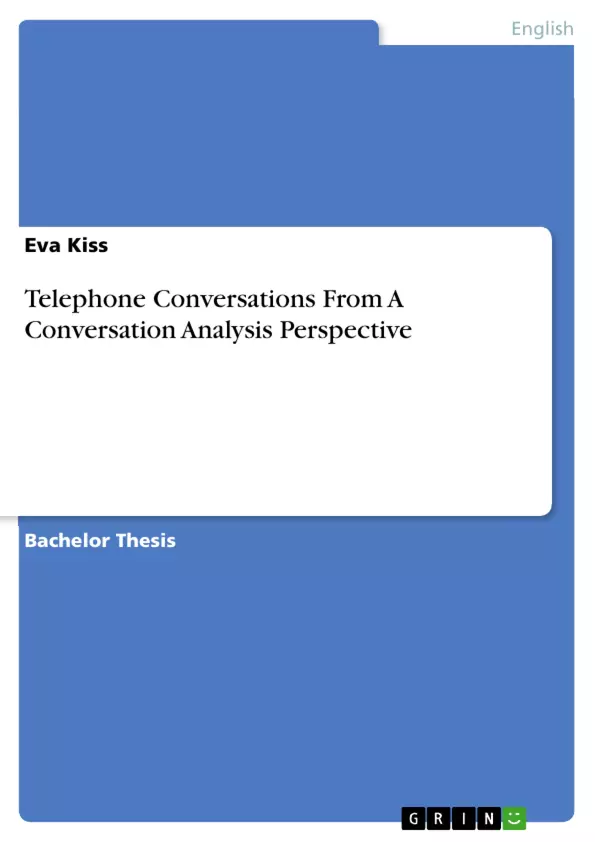Although we converse almost every day, we never have exactly the
same conversation twice. Nevertheless, certain parts of
conversations occur in forms which are very alike. They seem to be
constructed according to sets of rules. These rules were examined in
the 1970’s for the first time.
The mechanisms which govern our conversations are especially
observable in telephone conversations. But since the 1970’s, new
technologies have come up and society changed.
The aim of this paper is to examine the mechanisms of telephone
conversation and how the systems working in telephone conversations
have changed since the establishment of the mobile telephone.
For this, the focus on Conversation Analysis as research methodology
is explained, before coming to the basic features of every
conversation. Following this, telephone conversations are examined
according to their structure of opening, topic-talk and closing.
Finally, the changes of this structure for mobile telephone
conversations are pointed out.
The basis for the observations on mobile telephone conversation is a
survey carried out among 20 Canadian citizens and material provided
by the participants of the survey. Two different main methodologies exist for analysing and examining
conversation – conversation in general, or telephone conversation in
special – from a linguistic perspective: Conversation Analysis and
Discourse Analysis. To understand my decision to focus on the
discipline of Conversation Analysis, I will shortly point out the
main differences and parallels of these methodologies.
Of course, both disciplines examine conversation. But the methods
used for this, the thereby resulting findings and the main
understanding of conversation differ immensely. A common aim of Conversation Analysis and Discourse Analysis is to
be able to give “an account of how coherence and sequential
organization is produced and understood” (Levinson 1983: 286).
Discourse Analysis uses primitive and basic concepts of linguistics
for this. It attempts to extend the rules applying to sentences over
the boundaries of sentences. The main method of the discipline is
the isolation of sets of units of discourse, followed by a
formulation of rules according to these units and finally the
division of units into well-formed and ill-formed sequences. [...]
Table of Contents
- I. INTRODUCTION
- II. TELEPHONE CONVERSATION FROM A CONVERSATION ANALYSIS PERSPECTIVE.
- 1. CONVERSATIONAL BASICS.
- 1.1. Conversation Analysis versus Discourse Analysis.
- 1.2 Conversation.
- 1.2.1 Definition of Conversation.
- 1.2.2 Turn-taking.
- 1.2.3 Adjacency Pairs.
- 1.2.4 Preference Organization.
- 1.2.5 Problems in Conversations.
- 2. TELEPHONE CONVERSATION
- 2.1. Basics
- 2.2 Openings
- 2.2.1 Summons-Answer.
- 2.2.2 Identification and Recognition.
- 2.2.4 Opening Structure...
- 2.3 Topic talk..
- 2.4 Closings.
- 2.4.1 Terminal Exchange and Pre-closing..
- 2.4.2 Closing Components and Re-opening
- 2.4.3 Special Closings.
- 3. MOBILE TELEPHONE CONVERSATION
- 3.1 Basics
- 3.2 Openings
- 3.3 Topic-talk.
- 3.4 Closings....
- III. CONCLUSION.
Objectives and Key Themes
This paper aims to examine the mechanisms of telephone conversation and how these systems have changed since the introduction of the mobile telephone. The paper focuses on the research methodology of Conversation Analysis to explore the basic features of conversation, followed by an examination of telephone conversations in terms of their opening, topic-talk, and closing structures. Finally, the paper highlights changes in this structure for mobile telephone conversations.
- The impact of technological advancements on communication patterns
- The application of Conversation Analysis in examining telephone interactions
- The structure and organization of telephone conversations
- The differences and similarities between traditional and mobile telephone conversations
- The influence of social and cultural context on conversational patterns
Chapter Summaries
The introduction sets the context for the paper by discussing the ubiquity of conversation and highlighting the need for a deeper understanding of its structure and organization. It introduces Conversation Analysis as the chosen research methodology and outlines the paper's structure.
Chapter II delves into the core concepts of Conversation Analysis, contrasting it with Discourse Analysis. It explores the basic features of conversation, including turn-taking, adjacency pairs, preference organization, and common problems encountered in conversations. This section provides a theoretical framework for understanding the structure of telephone conversations.
Chapter II then focuses specifically on telephone conversations, examining their opening sequences, topic-talk, and closing strategies. It explores the role of summons-answer sequences, identification and recognition, and various opening structures. The chapter also discusses the mechanics of closing conversations, including terminal exchanges, pre-closings, closing components, re-opening, and special closing practices.
Chapter III examines the unique characteristics of mobile telephone conversations, focusing on their openings, topic-talk, and closings. It explores how the introduction of mobile technology has influenced conversational practices and how these practices differ from traditional telephone conversations.
Keywords
The paper centers on the study of communication, specifically focusing on telephone conversations, Conversation Analysis, discourse analysis, turn-taking, adjacency pairs, opening and closing structures, and mobile phone conversations.
- Arbeit zitieren
- Eva Kiss (Autor:in), 2003, Telephone Conversations From A Conversation Analysis Perspective, München, GRIN Verlag, https://www.grin.com/document/30746



